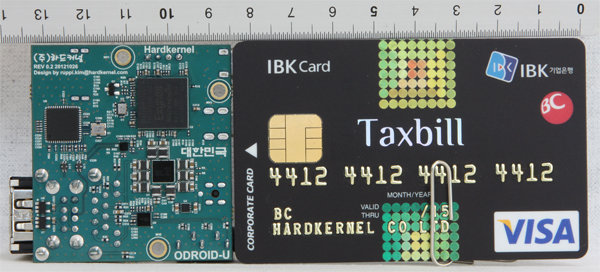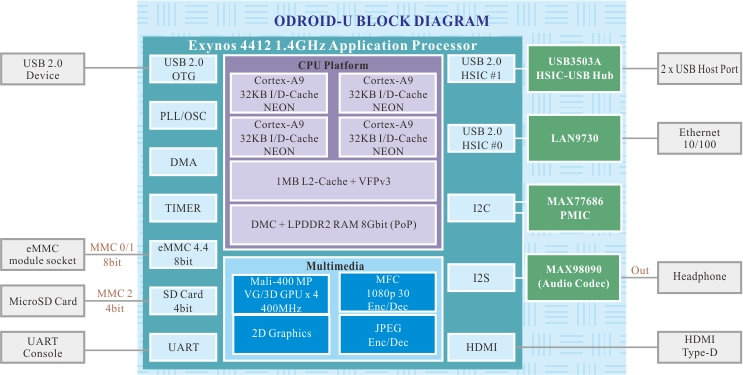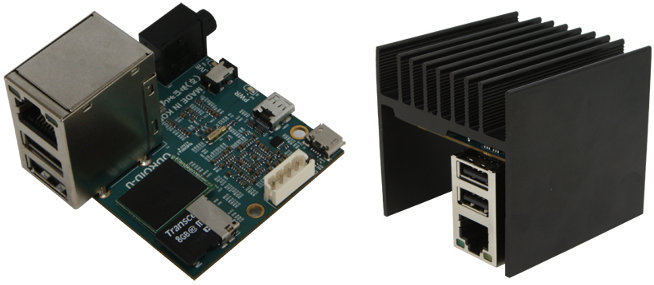Hardkernel has just announced 2 tiny quad core development boards based on Exynos 4412 @ 1.4 GHz (as used in Samsung Galaxy S3) and Exynos 4412 Prime @ 1.7 GHz (as used in Samsung Galaxy Note 2) called respectively ODROID-U and ODROID-U2. The other difference is the U version comes with 1 GB RAM, and the U2 version with 2 GB RAM.

Here are the specification the ODROID-U and ODROID-U2 boards:
- Processor – Samsung Exynos4412 @ 1.4 GHz (ODROID-U) or Exynos 4412 Prime @ 1.7 Ghz (ODROID-U2), which can be overclocked respectively to 1.8 GHz and 2 GHz.
- GPU – Mali-400 clocked at 400MHz (ODROID-U) or 440MHz (ODROID-U2), which can be overclocked respectively to 533 and 633 MHz.
- System Memory – 1GB LPDDR2 DRAM @ 800MHz (ODROID-U) or 2GB @ 880MHz (ODROID-U2)
- Storage – microSD socket, eMMC connector
- USB – 2x USB 2.0 Host ports, 1x USB 2.0 device for ADB/mass storage
- Ethernet – 10/100Mbps (LAN9730)
- Video Output – micro HDMI
- Audio Output – 3.5mm Jack
- Audio Input – Digital Microphone (ODROID-U2 only)
- System Console – UART (1.8Volt)
- DC Power – 5V/2A
- PCB Dimension – 48 x 52mm
- Heat Sink – 56 x 59 x 60mm

As with the ODROID-X, Hardkernel will provide Android Jelly Bean and Ubuntu images and source code. Schematics will also be made available but only on the 31st of January 2013.
 As you can see from the picture above, ODROID-U(2) boards will be shipped with an aluminum heatsink that will also serve as a case for the board. Most of ODROID-X modules (See unboxing) will be available for the platforms excluding LCD screen and Camera module which are not available for the new platform. Watch the video below for a tour of the board, accessories and see what you can do in Ubuntu (web browsing in Firefox, printing in Libreoffice…).
As you can see from the picture above, ODROID-U(2) boards will be shipped with an aluminum heatsink that will also serve as a case for the board. Most of ODROID-X modules (See unboxing) will be available for the platforms excluding LCD screen and Camera module which are not available for the new platform. Watch the video below for a tour of the board, accessories and see what you can do in Ubuntu (web browsing in Firefox, printing in Libreoffice…).
Hardkernel also announced further details about ODROID-X2 board (same as ODROID-X board but with Exynos 4412 prime and 2 GB RAM) that will be sold for $135 (instead of $149 previously announced) and be available on the 10th of December 2012.
ODROID-U & ODROID-U2 can be pre-ordered now for respectively $69 and $89 + $30 for worldwide shipping, and shipping is expected to start on Jan. 16, 2013 and Dec. 21, 2012. That’s really good value for quad-core development boards, and it looks like I might be able to review ODROID-U2 soon…

Jean-Luc started CNX Software in 2010 as a part-time endeavor, before quitting his job as a software engineering manager, and starting to write daily news, and reviews full time later in 2011.
Support CNX Software! Donate via cryptocurrencies, become a Patron on Patreon, or purchase goods on Amazon or Aliexpress





There are also two other videos showing the ODROID-U2 in action:
Android + OpenNI + OpenCV + PCL on ODROID-U2 : http://youtu.be/SBQBx7BgCKc
ODROID-U2 XBMC 12.0 Demo : http://youtu.be/O3v0ydCG2yU
So this is an better-than-Raspi, which can run Ubuntu? If so … wow!!!
@Sander
For applications that can take advantage of multi-cores an ODROID-U is probably equivalent to 16-20 Raspberry Pi boards in terms of CPU performance. I think Hardkernel sells the board nearly at cost, like the Raspberry Pi foundation does. But it’s mainly for application development, since you don’t have headers to access the GPIOs.
Wouldn’t it be a good idea to scramble the numbers on the credit card in the picture? …
Or a very nice and tiny mediaplayer 😉
I will never understand why anyone would use Android for a media player. I mean do you seriously intend to watch movies with a taskbar and clock in the bottom of the screen? Then there’s the whole performance overhead of Android itself, poor UI for TV usage, lack of stock audio bitstreaming, etc. That GPU should be able to achieve much better than 37 fps for such a simple UI as shown in the XBMC video. They should focus on the Linux version of XBMC instead. Hopefully a quad-core at 2Ghz is enough for software decoding of all the other codecs as they only seem to support h.264 hardware acceleration.
I have ordered a U2, will be interesting to see what i can do with it.
It’s a nice price and all, but keep in mind that most would probably order it with a 9$ PSU, then comes storage: SD or eMMC, and the list goes on (wifi etc.), in the end it really isn’t all that cheap compared to some of the chinese devices.
It would be nice if they (hardkernel) were to release a exynos 5 based product, with PCIe based gigabit ethernet, in my opinion the arndaleboard by insignal is just too expensive(and it doesnt even have gigabit ethernet either)
Also the prices for U and U2 is $69 and 89$ respectively excluding shipping, not including as the text says.
BTW: with the heatsink (why?) and the high-rising ethernet connector it looks quite bulky …
@Sander van Rossen
It seems to be a part number of processor… even I’m not sure.
@Rune TM
Why do you need the gigabit ethernet?
Are you considering any cluster computing?
@Sander van Rossen
4412 is the code for the Exynos processor. The card has obviously gone throuh some photoshop, unless you can now ask for vanity numbers on credit cards 🙂
@Mark
From a technical standpoint, you’re absolutely right. XBMC UI get over 40 fps with Allwinner A10 in Linux. But it’s just so much easier with Android because the SoC vendors support it. You easily get 2D/3D acceleration because SoC vendors always provide up-to-date libraries and drivers for Android, and I understand there’s (more or less) a common video framework which make it easy to run an app accross devices. There are also some workaround to Android issues. You can provide a proper TV launcher for Android (IMHO this one looks good), there is a paid app (Hidebar) to remove the status bar, so it’s technically possible to do.
The other thing is that Hardkernel has probably no intention to work on XBMC. They just want to show it works and the performance of their board. In Android, they just have to install the apk and it works, but in Linux, they would have had to spent a lot of time to make it work.
@Rune TM
Sorry, I read “Worldwide shipping” as “Free Worldwide Shipping” on the site, which is not the case, as there a $30 shipping and handing fee. I updated the post.
The price is still competitive compared to other few quad core Chinese devices. Actually, I only know GK802/Hi802 freescale i.MX6 mini PC which sells for $89 (Charbax) and $99 (geekbuying), and Exynos is still a more power solution.
There should be a $99 Exynos 5 board / mini PC coming soon, possibly from InSignal. I don’t have enough information to write about it, but this seems like a legit rumor: http://lists.debian.org/debian-arm/2012/10/msg00058.html
@Sander
I think the heatsink is needed when you do things that use 4 cores for an extended period of time (e.g. build), and when you overclock the processor up to 2GHz. It might also be useful for people working on the power management in the kernel. There’s also an heatsink on the ODROID-X board which can’t really be overclocked.
I wasn’t talking about Android mentionin the small mediaplayer 😉
Android is for touch devices, this is clearly not a touch device. So the best would be a minimal rootfs based on buildroot, with only the kernel and needed libraries and binaries. Just like the others… (RPi, Pivos, Allwinner)
And who says says thing needs to decode in software 😉
@j1nx
“And who says says thing needs to decode in software”
According to their forum, it only has h.264 acceleration. They don’t have license to hardware decode anything else. This means software decoding for MPEG2 and VC1. It can probably handle software MPEG2 up to 1080p but not sure about VC1. There is also no working open-source VC1 decoder for interlaced content as you would find on Blu-Ray concerts, documentaries, etc. They should just sell optional codec licenses like the RPi does.
@Mark good point but does the hardware codec decoding just need activating ? .. the insignal equivalent on this states :
Graphics Mali-400 MP4 GPU (Quad Core) supporting OpenGL ES 1.2, 2.0 and OpenVG 1.1 APIs
Video Multi format video hardware codec : 1080p 30fps MPEG-4/H.263/H.264/MPEG-2/VC1
http://www.insignal.co.kr/wiki/index.php/Projects
Yes you are right. MPEG licenses are expensive and as this is officially a developers board, it has not been included. The RPi guys, did the same 😉 So I know for sure that the licenses can be bought in the future. One way or the other.
The MFC V4L2 implementation has support for h.264,h.263, MPEG4, MPEG2 and MPEG1. Some rumours say it already works on xbmc-linux
I have not heard anything about VC1
I think I’m going to test this board! I was waiting for a cheap Exynos like this. A pity they are not from China…
@mac me
Those are possible features of the Exynos 4, not necessarily of this low-cost board. Most of the VPU’s require signed microcode of some sort to be uploaded before they decode anything. The insignal boards were generally more expensive than the hardkernel ones so maybe they include more codecs. Someone would need to confirm exactly what codecs are supported on both the Arndaleboard and this Odroid one. That’s one advantage of the Chinese products vs. Korean – Chinese don’t seem to care about licenses and their cheap SoC decode all video formats.
@cnxsoft
ODROID-X boards are overclockable, some to 1.6 and some to 1.8. There are some statistics on their forum.
@Grox
It must be possible with some boards. But a few months ago, I asked Hardkernel if they had instructions to overclock the board, because I wanted to write a post about this, and they advised against it as they fried a few CPUs trying to do so. It’s possible there’s now a safer method, I haven’t checked.
@Mark
yep chinese SOC are great for last gen tech for dirt cheap tablets but their support of anything other than android/reference boarddesign) is god aweful … for anything other than its intended purpose (dirt cheap tablets) eg running linux
thankfully we have freescale and samsung who will hopefully make hacking these cheap chinese SOC boards all but practically irrelevant .. yay !
I’m waiting to see now the imx6 match this spec and prices … FIGHT 🙂
@Peter Steenbergen
4412 x 4… that’s not a real card number… nice try though
@mac me
Fight is on:
http://liliputing.com/2013/09/cubox-i-mini-pcs-run-android-or-linux-sell-for-45-and-up.html
Dear you,
I am Ms. Nhung from VP9 company in Viet Nam.
In present, our company has a demand in ODROID-HC1 with the technical specification as the following details:
Key features
* Samsung Exynos5422 Cortex-A15 2Ghz and Cortex-A7 Octa core CPUs
* 2Gbyte LPDDR3 RAM PoP stacked
* SATA port for 2.5inch HDD/SSD storage
* Gigabit Ethernet port
* USB 2.0 Host
* UHS-1 capable micro-SD card slot for boot media
* Size : 147 x 85 x 29 mm approx.(including Aluminium cooling frame)
* Linux server OS images based on modern Kernel 4.9 LTS
If your company has been available for this product, pls contact with me via email: nhungdth@vp9.vn or skype: dangnhung.klm and tell: +84 968 247 699
I am looking forward to hearing from you.
Thanks you